人教版英语七年级下册unit10导学案设计
- 格式:docx
- 大小:232.37 KB
- 文档页数:7
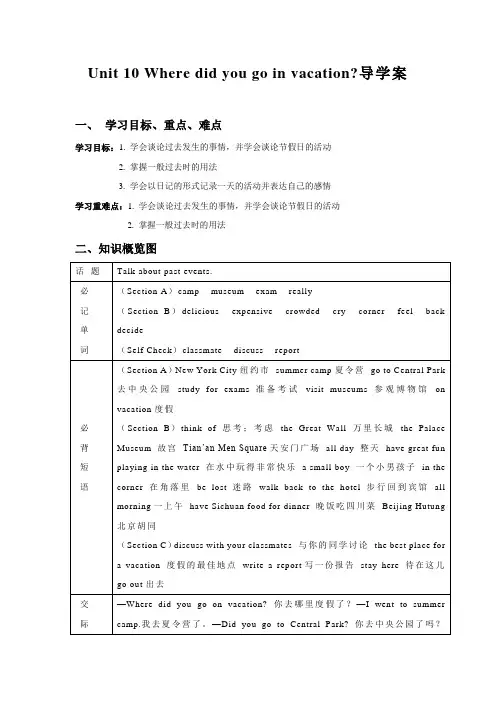
Unit 10 Where did you go in vacation?导学案一、学习目标、重点、难点学习目标:1. 学会谈论过去发生的事情,并学会谈论节假日的活动2. 掌握一般过去时的用法3. 学会以日记的形式记录一天的活动并表达自己的感情学习重难点:1. 学会谈论过去发生的事情,并学会谈论节假日的活动2. 掌握一般过去时的用法二、知识概览图三、新课导引The teacher asks the students the following questions:1. Do you like vacation? Why?2. Did you go on vacation?3. Where did you go?四、教材精华1. Where did you go on vacation?你去哪里度假了?这是一个一般过去时的特殊疑问句,其句式结构为“特殊疑问词+一般疑问句?”句中的特殊疑问词为where, did是助动词do的过去式。
On vacation为固定短语,意为“度假”,相当于on holiday.Where did he go last week? 上周他去哪里了?2. Did you / he /she/they go to Central Park?②你/他/她/他们去中央公园了吗?本句是含有实义动词的一般过去时的一般疑问句,助动词did 提前,原陈述句中的过去式改为原形,即“Did+主语+动词原形+其他?”其肯定回答为“Yes,主语+did”;否定回答为“No,主语+didn’t”.—Did she go to the beach? 她去海滩了吗?—Yes, she did./No, she didn’t. 是的,她去了。
/不,她没去。
was pretty good.相当好。
这是一个“主语+系动词+表语”句型,简称“主系表”结构。
pretty在这里为副词,意为“相当,非常”用于修饰形容词或副词。
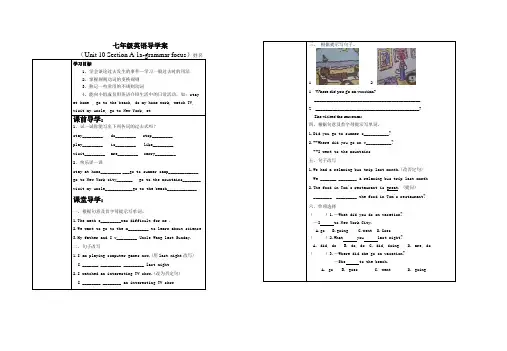
七年级英语导学案(Unit 10 Section A 1a-grammar focus)姓名学习目标1、学会谈论过去发生的事件—学习一般过去时的用法2、掌握规则动词的变换规则3、熟记一些常用的不规则动词4、能向小组成员用英语介绍生活中的日常活动,如:stay at home , go to the beach, do my home work, watch TV, visit my uncle, go to New York, et课前导学:1、试一试你能写出下列各词的过去式吗?stay_________ do_________ stop_________play_________ is_________ like_________visit_________ are_________ carry_________2、快乐译一译stay at home_________ ___go to summer camp_____________ go to New York city_______ go to the mountains________ visit my uncle____________go to the beach_____________ 课堂导学:一、根据句意及首字母提示写单词。
1.The math e_________was difficult for me .2.We want to go to the m_________ to learn about science3.My father and I v_________ Uncle Wang last Sunday.二、句子改写1.I am playing computer games now.(用last night改写)I _______ _________ _________ last night2.I watched an interesting TV show.(改为否定句)I ________ ________ an interesting TV show 三、根据提示写句子。
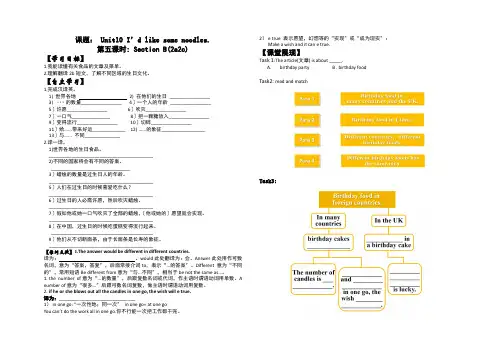
课题: Unit10 I’d like some noodles.第五课时: Section B(2a2c)【学习目标】1.我能读懂有关食品的文章及菜单。
2.理解翻译2b短文,了解不同区域的生日文化。
【自主学习】1.完成汉译英。
1) 世界各地2) 在他们的生日________________3) ···的数量________________ 4〕一个人的年龄________________5〕许愿________________ 6〕吹灭________________7〕一口气_______________ 8〕把一颗糖放入________________9〕变得流行________________ 10〕切碎________________11〕给......带来好运_____________ 12)......的象征_________________13〕与...... 不同______________2.译一译。
1)世界各地的生日食品。
_________________________________________2)不同的国家将会有不同的答案。
_______________________________3〕蜡烛的数量是过生日人的年龄。
_________________________________________5〕人们在过生日的时候喜爱吃什么?_________________________________________6〕过生日的人必需许愿,然后吹灭蜡烛。
_________________________________________7〕假如他或她一口气吹灭了全部的蜡烛,〔他或她的〕愿望就会实现。
_________________________________________8〕在中国,过生日的时候吃蛋糕变得流行起来。
________________________________________9〕他们从不切断面条,由于长面条是长寿的象征。
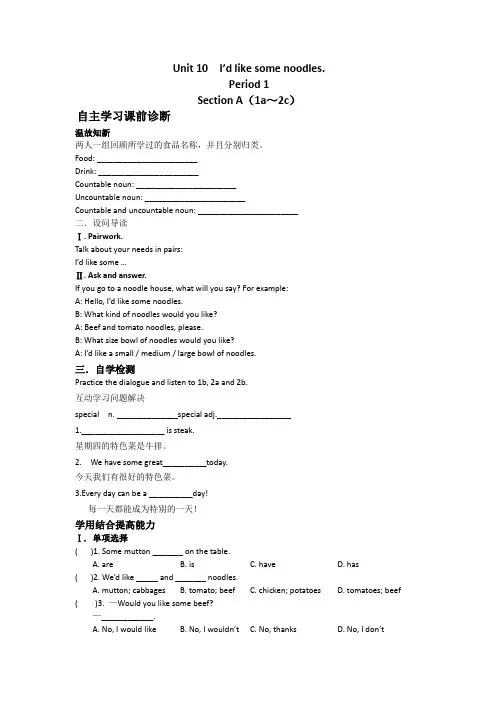
Unit 10 I’d like some noodles.Period 1Section A(1a~2c)自主学习课前诊断温故知新两人一组回顾所学过的食品名称,并且分别归类。
Food: _______________________Drink: _______________________Countable noun: _______________________Uncountable noun: _______________________Countable and uncountable noun: _______________________二.设问导读Ⅰ. Pairwork.Talk about your needs in pairs:I’d like some…Ⅱ. Ask and answer.If you go to a noodle house, what will you say? For example:A: Hello, I’d like some noodles.B: What kind of noodles would you like?A: Beef and tomato noodles, please.B: What size bowl of noodles would you like?A: I’d like a small / medium / large bowl of noodles.三.自学检测Practice the dialogue and listen to 1b, 2a and 2b.互动学习问题解决special n. ______________special adj._________________1.___________________ is steak.星期四的特色菜是牛排。
2. We have some great__________today.今天我们有很好的特色菜。
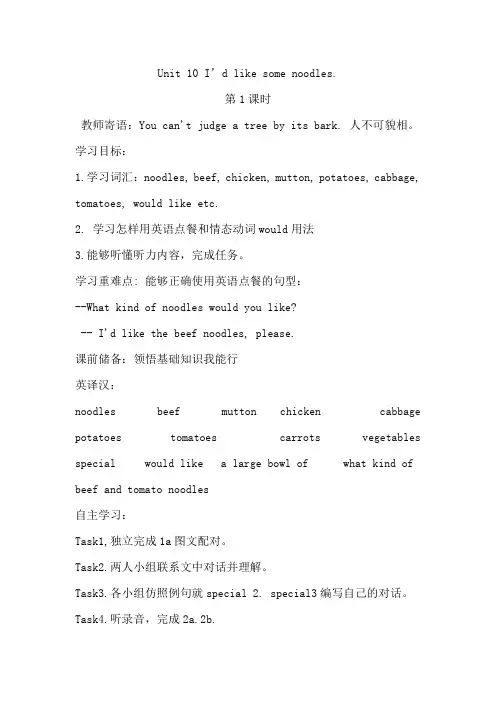
Unit 10 I’d like some noodles.第1课时教师寄语:You can't judge a tree by its bark. 人不可貌相。
学习目标:1.学习词汇:noodles, beef, chicken, mutton, potatoes, cabbage,tomatoes, would like etc.2. 学习怎样用英语点餐和情态动词would用法3.能够听懂听力内容,完成任务。
学习重难点: 能够正确使用英语点餐的句型:--What kind of noodles would you like?-- I'd like the beef noodles, please.课前储备:领悟基础知识我能行英译汉:noodles beef mutton chicken cabbage potatoes tomatoes carrots vegetables special would like a large bowl of what kind of beef and tomato noodles自主学习:Task1,独立完成1a图文配对。
Task2.两人小组联系文中对话并理解。
Task3.各小组仿照例句就special 2. special3编写自己的对话。
Task4.听录音,完成2a.2b.合作探究:1,1a中的名词中属于可数名词的是:_______________________________属于不可数名词的是_____________________________________________2,说话练习:-- What would you like? -- I'd like beef noodles,please. --What kind of noodles would you like?-- I'd like the beef noodles, please.注:1,would like的用法(1):would like 意为想要,愿意,相当于want,用于提出要求或建议;但语气比want委婉,一般有一下三种形式:①would like sth. 想要某物如:我想要些冰淇淋。
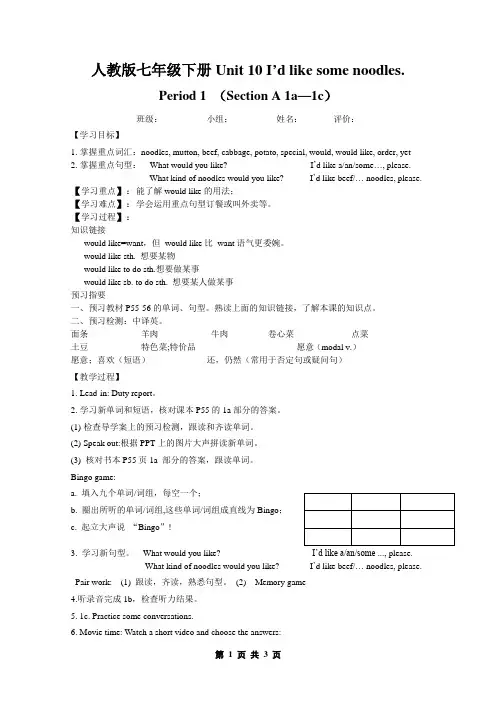
人教版七年级下册Unit 10 I’d like some noodles.Period 1 (Section A 1a—1c)班级:小组:姓名:评价:【学习目标】1.掌握重点词汇:noodles, mutton, beef, cabbage, potato, special, would, would like, order, yet2.掌握重点句型:---What would you like? ---I’d like a/an/some…, please.---What kind of noodles would you like? ---I’d like beef/… noodles, please. 【学习重点】:能了解would like的用法;【学习难点】:学会运用重点句型订餐或叫外卖等。
【学习过程】:知识链接would like=want,但would like比want语气更委婉。
would like sth. 想要某物would like to do sth.想要做某事would like sb. to do sth. 想要某人做某事预习指要一、预习教材P55-56的单词、句型。
熟读上面的知识链接,了解本课的知识点。
二、预习检测:中译英。
面条_________ 羊肉__________ 牛肉________ 卷心菜___________ 点菜_________土豆__________ 特色菜;特价品__________________ 愿意(modal v.)_______________ 愿意;喜欢(短语)_____________还,仍然(常用于否定句或疑问句)_____________【教学过程】1.Lead-in: Duty report。
2.学习新单词和短语,核对课本P55的1a部分的答案。
(1)检查导学案上的预习检测,跟读和齐读单词。
(2) Speak out:根据PPT上的图片大声拼读新单词。
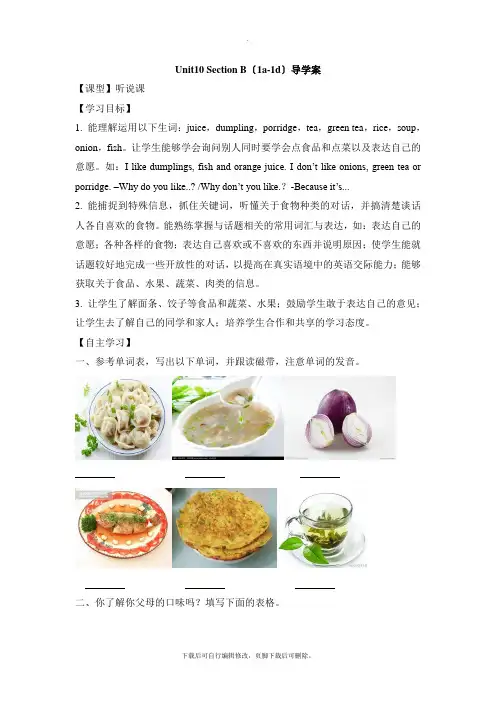
Unit10 Section B〔1a-1d〕导学案【课型】听说课【学习目标】1. 能理解运用以下生词:juice,dumpling,porridge,tea,green tea,rice,soup,onion,fish。
让学生能够学会询问别人同时要学会点食品和点菜以及表达自己的意愿。
如:I like dumplings, fish and orange juice. I don’t like onions, green tea or porridge. –Why do you like..? /Wh y don’t you like.?-Because it’s...2. 能捕捉到特殊信息,抓住关键词,听懂关于食物种类的对话,并搞清楚谈话人各自喜欢的食物。
能熟练掌握与话题相关的常用词汇与表达,如:表达自己的意愿;各种各样的食物;表达自己喜欢或不喜欢的东西并说明原因;使学生能就话题较好地完成一些开放性的对话,以提高在真实语境中的英语交际能力;能够获取关于食品、水果、蔬菜、肉类的信息。
3. 让学生了解面条、饺子等食品和蔬菜、水果;鼓励学生敢于表达自己的意见;让学生去了解自己的同学和家人;培养学生合作和共享的学习态度。
【自主学习】一、参考单词表,写出以下单词,并跟读磁带,注意单词的发音。
二、你了解你父母的口味吗?填写下面的表格。
【新课导入】Step 1: Lead-inAsk and answer: What’s your favorite food/drink/vegetables?〔头脑风暴:尽可能多地列举所学词汇,尤其是本单元的。
〕【新知呈现】Show these sentences:What kind of dumplings would you like?…dumplings, please.What’s your address, please?15 North Street.【新知学习】Step 2: Presentation1. Do you like these things? Show the pictures. Learn the new words in la.Listen and repeat after the recording,2. Match the words with the pictures. Write the letter of the food on the blank line before its name.〔跟读1a的录音,注意语音语调。
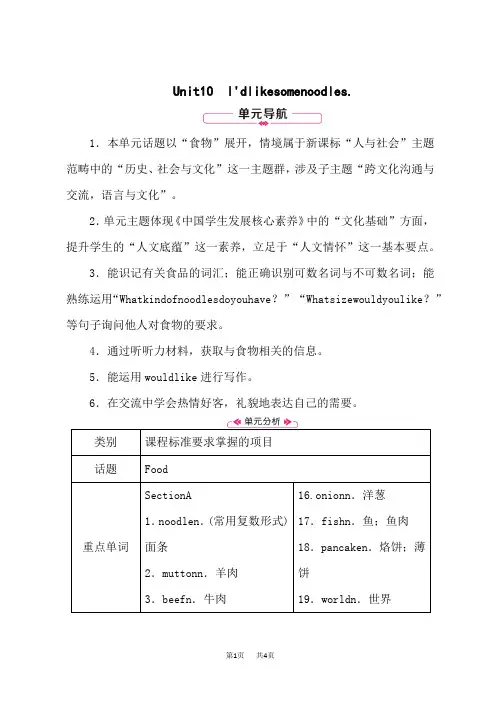
Unit10 I'dlikesomenoodles.
1.本单元话题以“食物”展开,情境属于新课标“人与社会”主题范畴中的“历史、社会与文化”这一主题群,涉及子主题“跨文化沟通与交流,语言与文化”。
2.单元主题体现《中国学生发展核心素养》中的“文化基础”方面,提升学生的“人文底蕴”这一素养,立足于“人文情怀”这一基本要点。
3.能识记有关食品的词汇;能正确识别可数名词与不可数名词;能熟练运用“Whatkindofnoodlesdoyouhave ?”“Whatsizewouldyoulike?”等句子询问他人对食物的要求。
4.通过听听力材料,获取与食物相关的信息。
5.能运用wouldlike 进行写作。
6.在交流中学会热情好客,礼貌地表达自己的需要。
续表
【课时建议】本单元建议5课时
SectionA(1a-1c)(一课时)
SectionA(2a-2d)(一课时)
SectionA(GrammarFocus-3c)(一课时)
SectionB(1a-1d)(一课时)
SectionB(2a-SelfCheck)(一课时)
词汇短语:主要采用图片及多媒体展示助记忆法。
基本句子:采用多媒体展示及交际法(利用多媒体展示两人进行交际时的情景)。
语法:学会如何点餐。
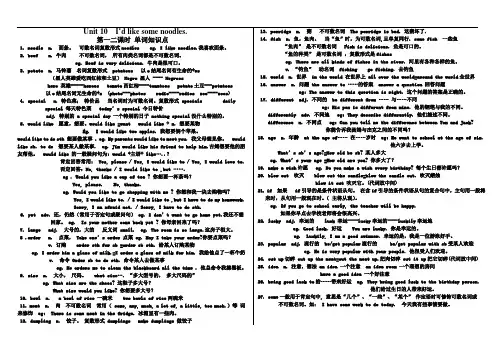
Unit 10 I’d like some noodles.第三四课时单词知识点some 用于疑问句时,表示建议、请求或希望得到肯定回答。
如:Would you like some coffee with sugar?你要加糖的咖啡吗?any 一般用于疑问句或否定句中, 意思是“任何一些”、“任何一个”, 作定语时可修饰可数或不可数名词。
如:They didn’t have any friends he re.他们在这里没有朋友。
any 用于肯定句时,意思是“任何的”. Eg. Come here with any friend. 随便带什么朋友吧。
28. the number of …….的数量。
后接复数名词,中心词为number,因此该短语主语时,谓语动词用单数。
eg. The number of students in our school is more than six thousand.我们学校学生数是6000多。
A number of许多的……. 。
做主语时,谓语动词用复数形式。
eg: A number of students in our school are friendly. 我们学校很多学生是友好的。
29. 名词:可数名词与不可数名词A、不可数名词,初中阶段常见的不可数名词有:water ; meat ; rice ; bread ; milk ; tea ;orange(桔汁) ; fruit ; air ; snow ; chalk; work ; paper(纸) ; time(时间); music ; weather ;grass ; news ; food ; fish(鱼肉); coke ; porridge ; cake(可数或不可数). 不可数名词应注意以下几点:1)前无数、冠,后无复数;作主语为三单.2)表量用约数some /any ; much ; a lot of 或用of短语eg. There is ____ bread on the table. [C]A. aB. oneC. a piece ofD. manyThere is some_______ on the plate. [B]A. appleB. fishC. milksD. deer2、可数名词的复数:A、不规则变化:man—men ; woman—women ;child—childrenpoliceman—policemenEnglishman—EnglishmenFrenchman—Frenchmenfoot—feet ; tooth—teeth mouse(鼠)—miceB、规则变化1)s; sh; ch; x 结尾加 es 读 [iz]2) ce; se; ze; (d)ge 结尾加 seg. boxes [b ksiz] blouses [blauziz]3)f (fe) 结尾则变f(fe)为v加es---读[vz]eg. knives [naivz] 4) “辅+y”结尾变y为i加es 清就清[s]5)一般加s 浊就浊[z]eg. books[buks] pens[penz] babies[beibiz]但注意以下几点:① potato—potatoes ; tomato—tomatoes②单复同形: fish ; sheep ; deer ; Chinese ; Japanese③由man , woman在词首构成的复合名词应将两部分都变成复数man doctor — men doctors④ reef—reefs⑤“某国人”的复数:中日不变英法变,其余s加后面. eg. German—Germans⑥ people , police 常用单数形式表示复数概念.eg. The police are looking for the missing boy.3、名词所有格:名词’s (意思是“……的”)A.有生命的名词所有格,一般在后加“’s”但注意:1)表两者共有则在后者加“’s”Lucy and Lily’s father 露西和莉莉的父亲Luc y’s and Lily’s fathers露西的父亲和莉莉的父亲.2)以s结尾的词只加“ ’ ”eg. 1) the boys’ books 2) James’ father3)无生命的名词所有格用of来引导eg. the leg of the desk4)双重所有格:a friend of my father’sa friend of mine ( √ ) a friend of my( × )练习:一、写出下列词的复数1.book______2.bus ____ __3.orange ___ ____4.baby__ ____5.boy__ ____6.my ____ ____7.his__ _____8.knife____ __9.watch______ __10.sheep ___ ___ 11. tooth __ ___12. leaf ___ _13.German___ _______ 14.Chinese_____ ____Unit 10 I’d like some noodles.orUnit 10 I’d like some noodles.自测一第十三课时一.根据首字母或汉语提示,写出单词。
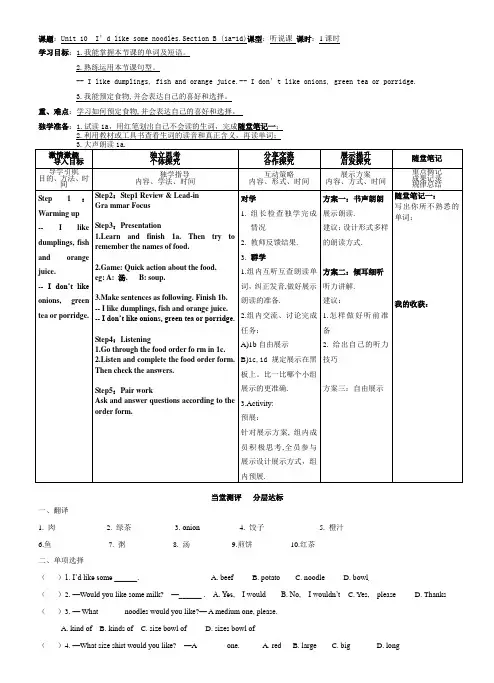
课题:Unit 10 I’d like some noodles.Section B (1a-1d)课型:听说课课时:1课时学习目标:1.我能掌握本节课的单词及短语。
2.熟练运用本节课句型。
-- I like dumplings, fish and orange juice.-- I don’t like onions, green tea or porridge.3.我能预定食物,并会表达自己的喜好和选择。
重、难点:学习如何预定食物,并会表达自己的喜好和选择。
独学准备:1.试读1a,用红笔划出自己不会读的生词,完成随堂笔记一;2.利用教材或工具书查看生词的读音和真正含义,再读单词;eg: A: 汤当堂测评分层达标一、翻译1. 肉_____________2. 绿茶___________3. onion __________4. 饺子______________5. 橙汁____________6.鱼______________7. 粥____________8. 汤___________9.煎饼__________10.红茶______________二、单项选择()1. I’d like some ______. A. beef B. potato C. noodle D. bowl()2. —Would you like some milk? —______ . A. Y es, I would B. No, I wouldn’t C. Y es, please D. Thanks ()3. — What ______ noodles would you like?— A medium one, please.A. kind ofB. kinds ofC. size bowl ofD. sizes bowl of()4. —What size shirt would you like? —A _______ one. A. red B. large C. big D. long()5. There ______ some food on the table. A. is B. are C. has D. have ()6. I’m hungry. I would like ______ a large bowl of dumplings. A. eating B. eat C. to eat D. ate()7. Do you like noodles ______ chicken? A. with B. of C. in D. for三、翻译1.我喜欢饺子,鱼和橙汁。
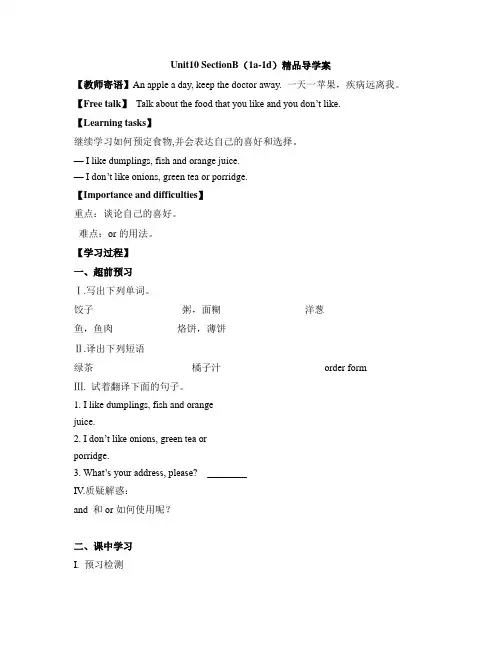
Unit10 SectionB(1a-1d)精品导学案【教师寄语】An apple a day, keep the doctor away. 一天一苹果,疾病远离我。
【Free talk】Talk about the food that you like and you don’t like.【Learning tasks】继续学习如何预定食物,并会表达自己的喜好和选择。
— I like dumplings, fish and orange juice.—I don’t like oni ons, green tea or porridge.【Importance and difficulties】重点:谈论自己的喜好。
难点:or的用法。
【学习过程】一、超前预习Ⅰ.写出下列单词。
饺子________________ 粥,面糊________________ 洋葱______________ 鱼,鱼肉____________ 烙饼,薄饼_____________Ⅱ.译出下列短语绿茶_________________ 橘子汁__________________ order form_________ Ⅲ. 试着翻译下面的句子。
1. I like dumplings, fish and orangejuice.___________________________________________2. I don’t like onions, green tea orporridge.___________________________________________3. What’s your address, please? _________________________________________ IV.质疑解惑:and 和or如何使用呢?__________________________________________________二、课中学习I. 预习检测II. 解决疑惑自主互助学习知识剖析:I like dumplings, fish and orange juice. 我喜欢饺子、鱼和橙汁。
Unit 10 I’d like some noodles.Section A Grammar Focus— 3c知识目标:1. Key words: meet2.Target Language:(1)----What kind of noodles would you like ?---- I’d like beef noodles ,please.(2) ----What size would you like ? ---- I’d like a large bowl ,please.(3)---- Would you like a large bowl? ---- Yes ,please.(4) ----Is there any meat in the tomato and egg soup? ---- No , there isn’t any ./ No , there’s no meat.能力目标:To order food freely and tell countable nouns and uncountable nouns . (自由地订餐并且能说出可数名词和不可数名词。
)情感目标: To learn how to ask and order the food politely.(学会如何礼貌地询问和订餐。
)【学习重点】:本节课的词汇和句子。
【学习难点】:1.掌握可数名词和不可数名词的用法。
2、学会如何礼貌地预定食物。
【学法指导】:1.了解一些我们吃的蔬菜和面食,熟读句子理解其意思。
【自主学习】:任务一:重点句型(完成译句):1.你想要什么面?请给我来碗牛肉面。
2.你想要多大碗的?我想要一个大碗。
3.你想要个大碗吗? 是的。
4.西红柿鸡蛋汤里有肉吗?不,没有肉。
【合作探究】:探究一:小组合作,热身练习。
小组内大声朗读Grammar Focus 中的句子,理解其意思,选代表在全班展示。
七年级下册英语学案第080号Review of Unit 10Ⅰ.单项选择(10分)( ) 1. —Would you like something to eat?—_______. I’m not hungry.A. Yes, I’d like toB. Yes, I’d love toC. No, thanks( ) 2. —_______? —I’d like a cup of tea.A. Would you like some teaB. Can you help meC. Do you like tea ( ) 3. —Do you want a big watermelon(西瓜) or a _______ one?—A big one, please.A. thinB. smallC. heavy( ) 4. He is too hungry and he wants two _______.A. bowl of noodlesB. bowls of noodlesC. bowls of noodle( ) 5. —What _______ coat would you like?—A medium one.A. sizeB. kindC. color( ) 6. —Let’s do something at the party. What about _______?—No, I’d like _______.A. to sing; to danceB. to sing; dancingC. singing; to dance( ) 7. —Would you like green tea _______ juice?—I don’t like green tea _______ juice.A. and; andB. or; orC. and; or( ) 8. Look! Some chicken _______ on the plate(盘子). And some eggs _______ in the bowl.A. is; isB. are; areC. is; are( ) 9. I often eat some _______ and _______ on Sunday evenings.A. tomatoes; fishB. tomato; fishC. tomatoes;fishes( ) 10. —What size pizza _______ Lily like?—She _____ like a large pizza.A. does; isB. is; wouldC. would; wouldⅡ. 用所给单词的适当形式填空。
Unit10 Section A〔2d-3c〕导学案【课型】阅读语法课【学习目标】1.能够掌握本课order,bowl,size,tofu 等词汇,运用核心句型May I take your order?-We’d like one bowl of beef soup? -Sure. What size would you like? -Large,please.等进展订餐或叫外卖活动。
2. 通过订餐对话活动让学生学会订餐和讨论饮食爱好,并在真实或模拟的语境下,运用所学的语言进展交际活动,通过语法的学习让学生能够正确运用可数名词和不可数名词、不定代词some/any和would like。
3. 能掌握订餐或叫外卖等的用语,体会学习英语的乐趣,做到“在用中学〞“在学中用〞。
学习过程【自主学习】将对话补充完整后,三人一组模拟面馆情景准备课前表演。
Waiter:?Boy: I’d like a large bowl of noodles.Waiter: And ?Boy: I’d like chicken, potato, and cabbage noodles.Waiter:?Girl: I’d like a medium bowl.Waiter:?Boy: I’d like beef and tomato noodles, please.【新课导入】Step l: Warming-up and lead-in1. Ask and answer questions with your partner, Use the formation in 2a.2. Show the conversations of 2a on the big screen to the students.3. Make a model for the students.T: What kind of noodles would you like?S: I’d like beef noodles, please....4. Students work in pairs and practice the conversation.【新知呈现】Step 2: Role-play1. Ask students to read the conversation in 2d and find the answer to this question: What would they like?(They would like one large bowl of beef soup, one gongbao chicken, and one mapo tofu with rice.)2. Check the answer with the students.3. Students work with their partners and role-play the conversation.4. Language points.【新知学习】Step 3: Grammar Focus1. 学生阅读Grammar Focus中的句子,然后做练习。
Unit 10 I’d like some noodles.Section A 1a — 1c (P55)【学习目标】倾心于课堂,畅游于学海,致力于改变命运!Believe that ,English is very easy!1、学习常用食物词汇;2、学会如何预定食物。
句型:--What would you like? -- I’d like some….【体验学习】I:预习交流(必须在课前完成预习内容,组长要发挥领导带头作用,督促大家完成任务)根据单元标题和图片等,预测新课内容;根据音标拼读单词并牢记;自学课文,勾画出重点和疑惑。
II、翻译官(此部分内容,大家必须在预习时完成,课堂上老师将会检查,并且在第二节课上听写)1. 想要,喜欢_________________2. 牛肉面____________________4. 鸡肉_____________________5. 羊肉______________________3. 卷心菜___________________ 6. 胡萝卜_____________________7. 土豆(复数) _______________ 8. 西红柿(复数) _______________9. special ___________________ 10. 我还没想好。
_______________【课堂导学】(此部分内容为新授课学生课堂任务,学生必须先独立完成,然后在组内讨论核实并展示,之后在课堂上给大家展示)1.头脑风暴:试着写出你知道的食物的名字。
________________________________________________。
2.学习1a中的新单词,将单词与图片搭配起来。
3.理解和练习1a中的对话,然后编写出自己的对话。
【自主检测】:(对于以下各部分的内容,我们将利用课堂时间完成,首先自己做,然后组内讨论,做完后老师检查并核实答案,同学们可以大胆举手提出自己的疑惑)I、精挑细选( ) 1. –What’s her favorite vegetable?--__________.A. Eggs.B. Bananas.C. Cabbages.( ) 2. Dale likes _______ very much.A. tomatoB. tomatoesC. tomatos( ) 3. What would you like _______ breakfast?A. forB. onC. atII、完美呈现1.Some _________ (beef) is in the box.2.Mutton _________ (be) my favorite food.3.Bring me some __________ (orange), and I want to make orange juice.4.I like rice. But my sister ____________ (not like) it.Ⅲ、连词成句1.you, like, what, would (?)___________________________________________________________2.noodles, like, please, the, I’d , beef (.)___________________________________________________________3.sure, not, I yet, am (.)___________________________________________________________【快乐链接】英汉连线对对碰:Match each word with the right Chinese meaning.。
Unit10单词过关(沿中线折叠,完成英汉互译)
词汇梳理(沿中线折叠,完成英汉互译)
短语归纳(沿中线折叠,完成英汉互译)
用法总结
1.询问某人想要什么:
What would you like?您想要什么?
What size would you like?您想要什么型号/尺码的?
2.询问是否有某物:
一Is/Arethere+主语+其他?······有······吗?
—Yes,thereis/are.,thereisn't/aren'tany.是的,有。
/不,没有。
3.请求点菜的句型:
May Itake your order?您可以点菜了吗?
4.主谓一致:The number of+可数名词复数+谓语动词的第三人称单数形式+其他
The number of the students in the school is three thousand.
5.it作形式主语:lt is+形容词/其他+动词不定式短语.
语法练习
1、would like用来表达意愿,意为“想要,愿意”,和want语义相近,但语气委婉、客气。
其
后接名词、代词宾格或to do。
常见句型:Would you like to do…?你愿意做……吗?
如:I would like a cup of tea. 我想要一杯茶。
I would like him to go there. 我想要他去那。
Would you like to join us? 你愿意加入我们吗?
1)I think he would like______shopping with me. (to go/go)
2)I would like ______ basketball to become stronger.(play/to play)
3)My brother ______ an orange.(would like/would)
4)Morris would ______ some friends to his party this weekend.
A like inviting
B like to invite
C to invite
D inviting
2、可数名词与不可数名词
5)I can see two______(woman)standing under the tree.
6)These four______(小刀)on the table are mine.
7)The boy brushes his______(牙齿)every day before he goes to bed.
8)How many______are there in your hospital?
A man doctors
B men doctors
C men doctor
D man doctor
9)______(German)are flying back to their country.
10)Two______ will come to the village.
A woman teacher
B women teacher
C women teachers
D woman teachers
写作
书面表达。
假如你是张林,你的舅舅经营了一家餐厅,请你根据下面表格中的信息帮他在你们学校的留学生论坛上刊登一则英文广告。
要求:60词左右。
答案
语法练习
1.to go
2. to play
3. would like
4. B
5. women
6. knives
7. teeth
8. B
9. Germans
10.C
写作
Happy Time is a great restaurant in the south of the school. At the Happy Time, you can have great food and drink. Dumplings and noodles are our specials. You can also choose rice, hamburgers or pizza here for your meals. Juice, tea and coffee are at low prices. After meals, you can enjoy many kinds of desserts, such as ice-cream and cakes. Welcome to Happy Time to have a great meal!。